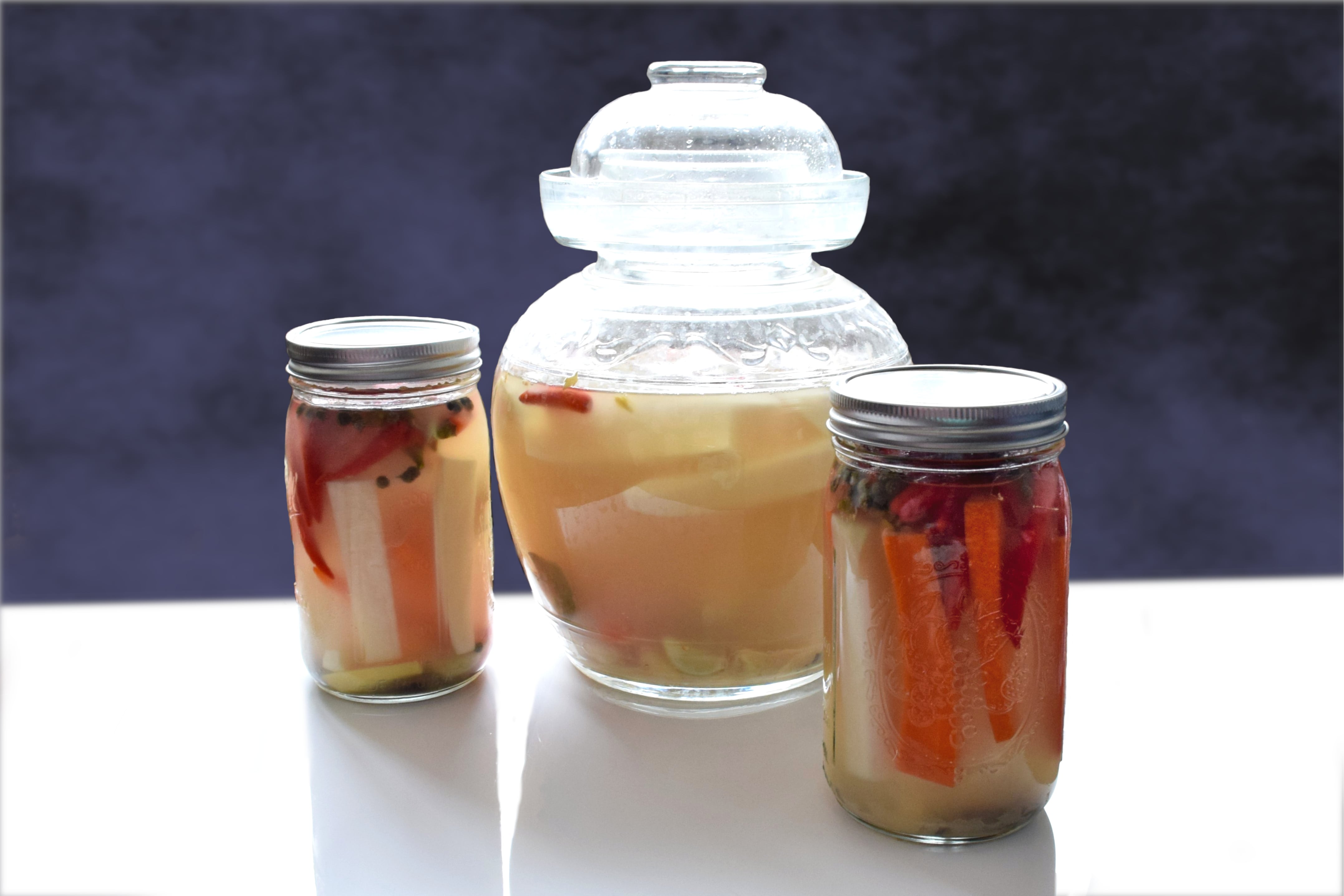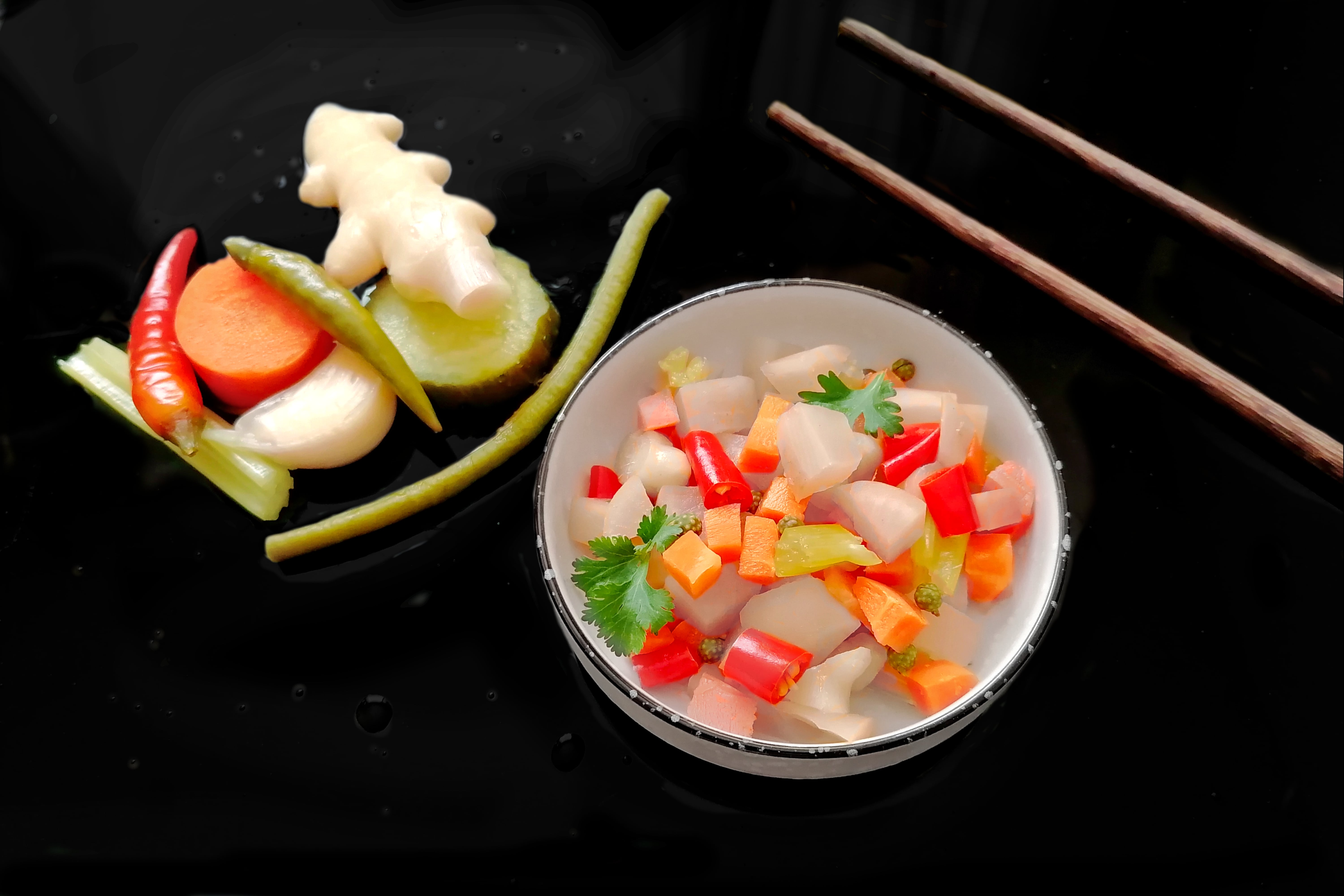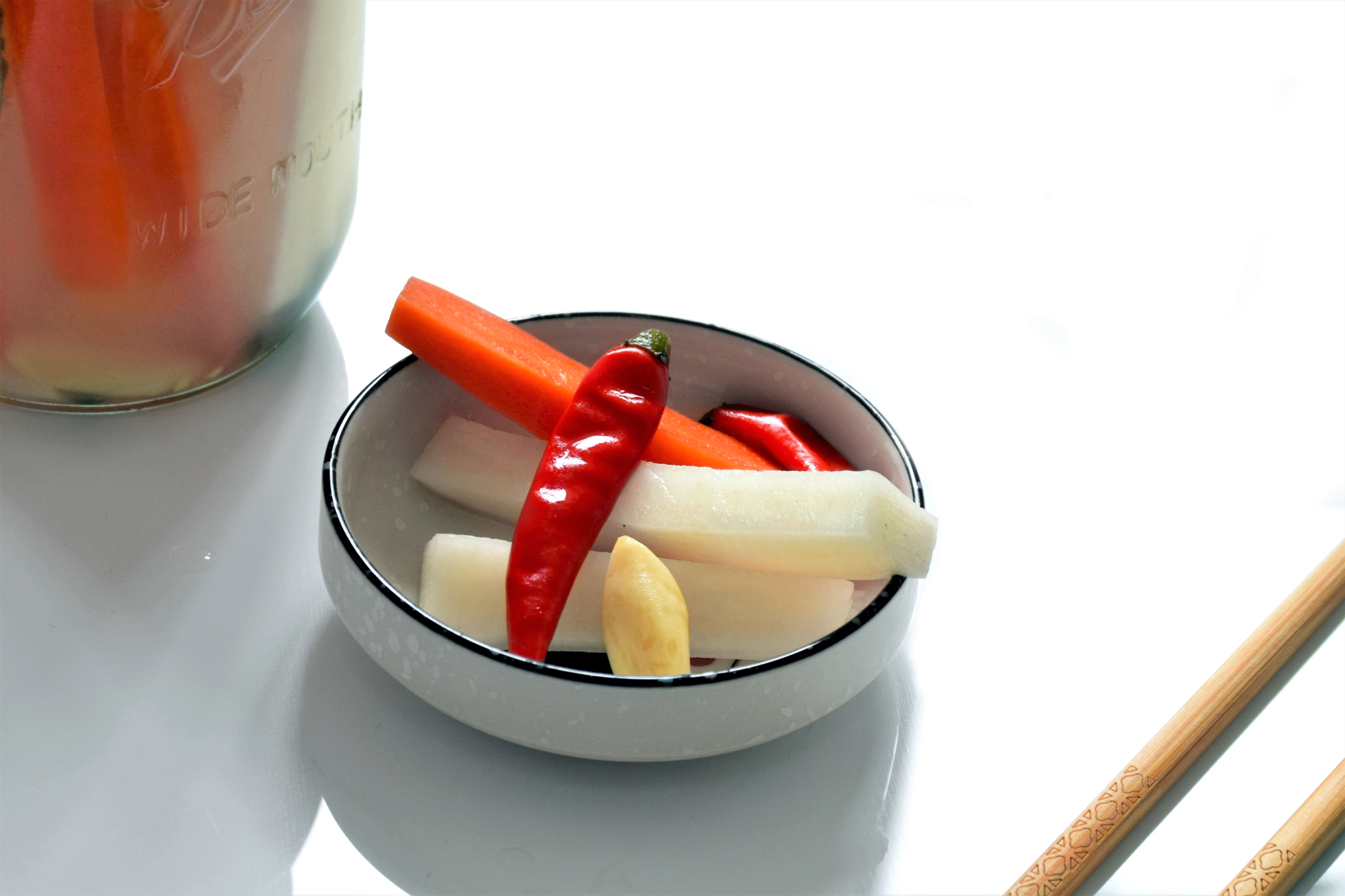The Ultimate Guide to Sichuan Pickles
Sichuan Paocai (四川泡菜)
Sichuan pickles are the pride of Sichuan cuisine – they are the ultimate in Sichuan flavor and the core ingredient in the majority of Sichuan dishes. The need to make your own Sichuan Pickled Vegetables cannot be understated.
Sichuan Pickled Vegetables use lacto-fermentation to pickle vegetables, so these are not true pickles in the sense that they are brined in vinegar and pasteurized. In reality they are fermented vegetables in which a saline solution is used to increase the lactobacillus, a probiotic used in yogurt and cheese. This is done as the glucose (a type of sugar) is turned into lactic acid, hence the name lacto-fermentation.
Sichuan Pickles have a rather high percentage of salt to water at around three percent. This is because Classic Sichuan Pickles are designed to include numerous types of vegetables, roots, and aromatics in one jar. Classic Sichuan Pickles also allow other vegetables to replace ones that are used, similar to the way more dough can be added to a sourdough starter. This can be done several times without needing to add more salt or alcohol. Modern Sichuan Pickles, likewise, use a ratio of about 3%, but since these can be rather salty, you can reduce the salt ratio to about 2.5% if making the pickles for snacking. Unfortunately, Modern Sichuan Pickles shouldn’t have replacement vegetables added – once the pickles are used up, it’s time to start over with a new batch.
From this, we can already start to derive several advantages and disadvantages of both Classic and Modern Sichuan Pickles. Modern Sichuan Pickles only allow for a few types of vegetables and aromatics to be fermented at one time, whereas Classic Sichuan Pickles offer much more variety. Modern Sichuan Pickles are slightly easier to make and have a more accurate method of determining the salt to water ratio. (A lot of Sichuan people go more by feel and experience when determining the amount of salt, but without this knowledge and experience, it can be a bit risky to estimate the necessary amount of salt). Finally, Classic and Modern Sichuan Pickles require different equipment. For Classic Sichuan Pickles, you’ll need a special pickle jar with a rimmed lip that can be filled with water so that the upside-down-bowl-shaped lid can release gasses. Modern Sichuan Pickles require only a canning jar and a kitchen scale.
Remember to always work clean so that you don’t introduce oils or bacteria into the jar. Always use chopsticks or tongs to remove the pickles and never use your hands. The fermenting liquid should turn cloudy from fermentation, but there shouldn’t be mold on the surface of the liquid. However, do not be surprised if a white, spiderweb-like film develops over the surface. This is actually a sign you have a healthy lacto-fermentation happening. This white film is called Kham yeast. You will need to do some maintenance on the pickles as you won’t want this to increase (it can start to break-down the veggies and give them a slimy texture). To destroy the yeast, skim away as much yeast as possible with clean spoon, add more Chinese white liquor (白酒), cover the surface of the jar tightly with plastic wrap, and allow it to rest for ten days. After ten days, check the pickles and skim away any remaining yeast. More vegetables can then be added to the jar and fermented.
Classic Sichuan Pickles
Sichuan Paocai – Chuantong Fangfa (四川泡菜 – 传统方法)
Sour, salty, spicy, and aromatic – there are so many flavors that make Sichuan pickles so incredibly delicious – all of these flavors working together harmoniously.
Not only do Sichuan Pickles make a great appetizer, but they are also a staple of Sichuan cooking. Numerous dishes rely on the flavor-bomb that is Sichuan Paocai. Pickled chilies, garlic, and ginger can be added to nearly any Sichuan dish to enhance the flavor.
The pickling process is actually quite simple - a matter of basic science. Sichuan pickles rely on three crucial factors for pickling: Salinity, Fermentation, and Time.
To achieve that sour pickled flavor, numerous vegetables are submerged in a solution of water, salt, and strong alcohol. The ratio of water to salt is extremely important! Traditionally, this would be around 10-parts water to 1.6-parts salt. This ratio is not extremely precise, and many Sichuan people are able to estimate the proper ratio due to experience. More precisely, the amount of salt in grams needed should be about 3% of the total weight of all of the ingredients and water in the jar – obviously excluding the weight of the jar. In China, you can easily purchase pickle salt (泡菜盐); however, any finely ground salt should work well so long as it dissolves easily.
The initial ingredients used in Classic Sichuan Pickles are pretty standard: Aromatics, Vegetables, and Alcohol. So, Asian White Radish (Daikon), Red Chilies, Ginger, and Garlic are the common base ingredients. After these ingredients have been pickled, other vegetables can be added. These include leafy vegetables such as cabbage and mustard greens. Other great additions include cucumbers, green chilies, green beans, and celery. I use carrot in the following recipe as an optional additional ingredient but it can be substituted with any of the previously mentioned vegetables.
One of the alcohols used in the following recipe is a type of fermented rice wine (酒糟) with grains of rice floating in the alcohol. This rice wine has a bit of sweetness that helps the ingredients ferment faster. If you're unable to find it, you may be able to substitute it with a strong alcohol or liquor and slightly increase the amount of sugar.
Finally, this is not a fast process. It can take several days and up to a week to pickle the vegetables and achieve that complex sour, salty, spicy, numbing, and fragrant Sichuan Pickle flavor. However, after about ten days, vegetables will pickle quickly, usually within one to three days. (Obviously, vegetables will pickle based on density, so less dense vegetables will pickle faster).
A final note about the pickling process: start clean!
Before even adding water to the jar, ensure that everything is as sterile as possible. Wash your hands thoroughly with antibacterial soap and hot water. Clean the pickle jar as well as any items used for this process - this could include bowls, chopsticks, knives, tongs, etc. You can even use a little alcohol to disinfect them. Just be sure everything is clean. You want to remove as many variables as possible that might contaminate or introduce bacteria into your pickles. The fermentation needs to come from the probiotics and not from random microbes outside your control.
Ingredients
Spices
25 grams of Cassia Bark (OR Cinnamon; About 6 Sticks)
20 grams whole Star Anise (About 6 Stars)
10 grams Green Sichuan Peppercorns (About 1/4 cup)
3 grams dry Bay Leaves (About 6 Leaves)
Pickling Brine
3 liters of Water
240 grams of pickling Salt (OR any finely ground Salt)
40 grams Rock Sugar
30 grams Rice Grain Alcohol (酒糟 / 米酒)
1/2 head of Garlic (Peeled Optional)
150 grams of Red Chilies
Roots
500 grams of Daikon (Asian White Radish)
1 thick Carrot
150 grams of fresh Ginger (the fresher, the better)
Leafy Aromatics
40 grams of Parsley
40 grams of Cilantro
30 grams of green Scallion (香葱)
Alcohol
30 grams Chinese White Liquor (白酒)
Directions
1.) Place the Spices (Cassia Bark, Star Anise, Sichuan Peppercorns, and Bay Leaves) in a bowl and fill the bowl with clean water. Gently scrub the Spices to clean off any dirt and remove any possible contaminates. Strain the Spices and discard the water.
(Make sure your hands are clean prior to touching the Spices and scrubbing them with water).
2.) Thoroughly wash the Sichuan Pickle Jar. Pour a small amount of clear alcohol into the Pickle Jar and swirl it around the sides to sterilize the Pickle Jar. This jar needs to be as clean as possible.
3.) Fill the Pickle Jar a little over half full with 3 liters of Water. Add the Salt and mix until dissolved.
(The ratio of Salt to Water is extremely important! The ratio should be 10-parts Water to 1.6-parts Salt. An alternate, more modern way is to fill the Pickle Jar with all the ingredients first, add the Water, and record the weight minus the weight of the Pickle Jar. You can then multiply that amount by 0.03 to get the amount in grams of Salt needed. Pour out the Water into a large bowl, add the Salt to the Water, mix until dissolved, and pour the Salt-Water back into the Pickle Jar).
4.) Add the Spices to the Pickle Jar along with the Rock Sugar and pour in the Rice Grain Alcohol.
5.) Wash the Garlic cloves, optionally peel them, and add them to the Pickle Jar.
6.) If the Chilies have any stems, snip them short. Then, wash the Chilies and add them to the Pickle Jar.
7.) Peel the Daikon and Carrot. Cut off both ends of each Daikon and each Carrot leaving behind thick cylindrical middle sections.
8.) Place all of the Roots (Daikon, Carrot, and Ginger) in a large bowl, fill the bowl with clean water, and wash all the Roots thoroughly.
9.) Place the Daikon and Carrot back on the cutting board. Cut each in half lengthwise and then cut them half again creating long, roughly 6-inch-long batons. Place these batons into the Pickle Jar.
10.) Place the Ginger on top of the Daikon and the Chilies in the Pickle Jar.
11.) Place the Leafy Aromatics (Parsley, Cilantro, and Scallion) in a bowl of water and wash them thoroughly. Tie each of these Leafy Aromatics into knots and place them on top of everything inside the Pickle Jar.
12.) Pour the White Liquor into the Pickle Jar, submerging all the Leafy Aromatics. Place the bowl-shaped cover on the Pickle Jar and fill the outer rim with fresh water.
13.) Place the Pickle Jar in a cool, dark place. After 72 hours, remove and discard the Leafy Aromatics. The Sichuan Pickles can then be used for cooking, but it’s best to wait another 3 to 5 days.
Storage Notes: Sichuan Pickles will usually last up to one month, but should be preferably used within this time. Other vegetables can be added to the Pickle Jar and allowed to pickle to replace the Pickles as they are used. In this way, the pickling solution can be used for several months before needing replaced. (Don’t forget to add a little salt and alcohol every time large amounts of new vegetables are added and keep the rim of the Pickle Jar filled with a little water). If a white scum or film develops on top of the Pickles, don’t panic. This is somewhat normal. Simply skim off the scum as thoroughly as possible, add a bit more alcohol, and mix gently. However, if there is mold or rot on the Pickles themselves (i.e., below the water level), then it’s time to discard the Pickles and start fresh. My final advice: Keep an eye on the Pickles and use them regularly. Sichuan Pickles are actually quite easy to make and low hassle. The only problems that arise are when the Pickles are stored in the back of a cabinet and forgotten. So, check them occasionally, add ingredients as necessary, and enjoy your amazing Sichuan Pickles.
Modern Sichuan Pickles
Sichuan Paocai – Xiandai Fangfa (四川泡菜 – 现代方法)
Tangy, spicy Sichuan fermented pickles have layers of flavor from garlic, ginger, and chilies imbued with the aroma of aromatic dried spices like star anise, cassia bark, and bay leaves.
The main difference between these ‘Modern’ Sichuan Pickles and the ‘Classic’ Sichuan Pickles is the type of jar in which the pickles are made. They still undergo the same fermentation process with much the same flavors. However, instead of using a traditional Chinese pickle/ fermentation jar, these require a common mason jar. Since a mason jar cannot hold quite as much as a Chinese jar, you’ll more than likely need at least two 32-ounce jars.
The following recipe is actually a bit more precise when it comes to the fermentation process. Whereas the Classic Sichuan Pickles’ recipe relies on a bit of estimation (i.e., trial and error), this recipe is mathematically and scientifically accurate. You will need a kitchen scale and a calculator, but you’ll be guaranteed perfect Sichuan Pickles every time.
In order to make lacto-fermented pickles such as these, you will need to calculate the perfect amount of salt. Sichuan Pickles usually have a high salt ratio. The minimum amount of salt needed for lacto-fermented pickles is around 2% of the total weight of water and vegetables. However, for Sichuan Pickles, you should use a higher percentage – at least 2.5%. In the following recipe, I use the maximum amount which is 3%, an amount which worked great for me.
Ingredients
Roots
1 White Radish
1 Carrot
1 4-inch block of Ginger
10 Red Chilies
Aromatics (per Jar)
3 cloves of Garlic
3 sprigs of Cilantro
1 4-inch-long green stalk of Scallion
Spices (per Jar)
1 Bay Leaf
1 1-inch-long stick of Cassia Bark (OR Cinnamon)
1/2 Star Anise
1 tsp. Green Sichuan Peppercorns
1 Tbsp. Chinese White Liquor (白酒; per Jar, Plus More for Disinfecting the Jars)
1 1/4-inch-cube of Rock Sugar
Water and Salt (Amount Will Vary)
Directions
1.) Peel all of the Roots (Radish, Carrot, and Ginger) and cut them into sticks that will fit comfortably in your jar – the exact size is up to you but try to keep the sizes as even as possible. Place all of these into a large bowl.
(The Ginger can be cut into smaller sticks than the Radish and Carrot, but try to keep them uniform).
2.) Snip off the stems of the Red Chilies, if present, and place them in the bowl with the Roots.
3.) Prepare the Aromatics by peeling the Garlic and tying the Cilantro and Scallion into knots. Place the Aromatics in the bowl with the Roots and Chilies.
4.) Fill the bowl with water and gently massage everything, washing the ingredients. Drain the water completely and set the bowl aside.
5.) Add all the Spices (Star Anise, Bay Leaf, Cinnamon, and Sichuan Pepper) to a different bowl, fill the bowl with water, and gently massage everything, washing the ingredients. Drain the water completely and set the bowl aside.
6.) Pour a little strong liquor into a jar, turn the jar sideways over a sink, and gently rotate the jar to disinfect the inside. Place the jar on a kitchen scale and zero-out the weight of the jar.
(If your scale will not zero-out the weight, record the weight of the jar and subtract the weight later after adding the Water).
7.) With the jar still on the scale, add the tablespoon of Liquor, the Rock Sugar, and all of the Spices. Next, insert as many of the Roots and Chilies as you can and add the Aromatics on top of these.
8.) Fill the jar with enough Water to cover everything completely.
(If things float, make sure it’s enough water to cover everything but not so much that water overflows when a weight is added to submerge the pickles. Having the Cilantro and Scallion on top is best because these are meant to add flavor and not meant to be used as actual pickles).
9.) Record the total weight of everything in the jar using grams. Multiply the weight of everything by 0.03 to get the amount in grams of Salt needed.
(If your scale was unable to zero-out the weight of the jar, subtract the weight of the jar from the total amount. The math is rather simple. So, when I weighed everything in the jar, the total weight was about 840 grams. 840 x 0.03 = 25.2 grams of Salt. I found that the average weight of salt needed would be around 24.5 to 26.5 grams for 32 oz/ 1 L jar).
10.) Carefully pour out all of the Water into a bowl, set the bowl of Water on the scale, and zero-out the weight of the bowl. Slowly add the Salt until the weight reaches the precise amount. Stir the Water until the Salt dissolves completely.
11.) Carefully pour the Salt Water back into the jar covering all the vegetables. Set a small ramekin or weight in the jar so that the liquid completely covers every vegetable. Cover everything with a thin cloth. But DO NOT seal the jar.
(You can also use a plastic zipper bag filled with water to weigh everything down. If you want to place a lid on top, keep the lid cracked or else half covering the jar. You want your pickles to breathe).
12.) Store the Sichuan Pickles in a cool pantry away from sunlight for 10 days. After 10 days, the Pickles will be ready to use. Remove the weight inside the jar. Also, remove and discard the Scallion and Cilantro. You can now store the Sichuan Pickles in a fridge with a fastened lid. In the fridge, the Pickles should last for over a month; they will still ferment but at a much slower rate. Never use your fingers directly to remove Pickles from the jar.
Contribute to Sichuan Soul
Sichuan Soul is funded in part thanks to generous contributions by fans like you! Your donations supply Sichuan Soul with the funding needed to provide quality recipes and photos. All donations are processed safely and securely through PayPal. You can donate any amount using the 'Donate' button below. Thank you for your support.



Comments
Post a Comment